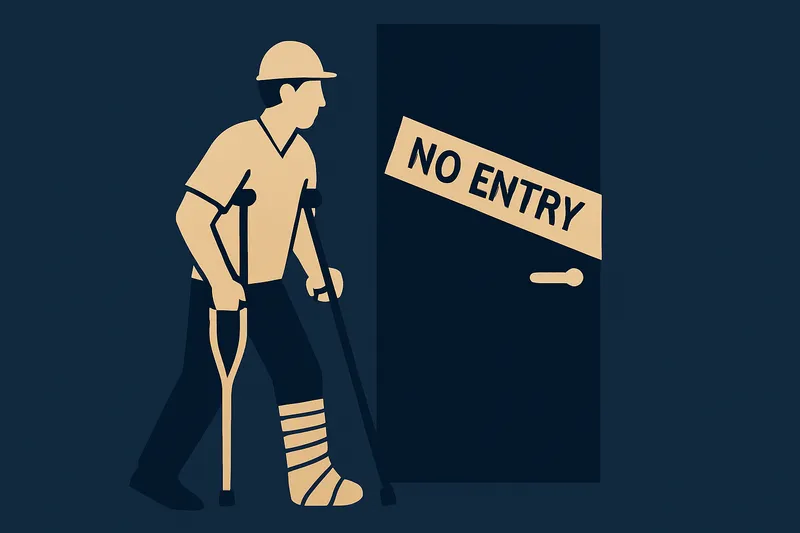How Doctors Should Determine Work Restrictions After a Work Injury

Published: 11/30/2024
When you’re hurt on the job, one of the first things that happens (after treating your injury) is your doctor issues work restrictions. These are specific limits on what you can safely do at work while you recover. Work restrictions serve an important purpose in the workers’ compensation process: they protect you from further injury and guide a safe return to work. In other words, they spell out what activities you should not do (and sometimes what you can do) on the job, given your medical condition. These restrictions are communicated to your employer and the insurance company to make sure everyone understands your current capabilities and limitations.
Why do we need work restrictions?
Imagine you have a back injury – if you immediately went back to lifting heavy boxes at work, you could hurt yourself all over again. The goal of restrictions is to avoid re-injury or harm while you heal. They also help your employer know if they can provide you with a light-duty or modified job. In a workers’ comp claim, having clear restrictions from your doctor is often required for you to receive benefits if you can’t do your normal job. Overall, work restrictions are there to keep you safe and support your recovery, while also documenting your work limitations for legal and insurance purposes.
AMA Guides and the Approach to Evaluating Work Ability
The AMA’s Guides to the Evaluation of Work Ability and Return to Work provide doctors with a framework for assessing an injured worker’s functional ability and establishing safe return-to-work guidelines. A core concept in the AMA’s approach is evaluating three key factors: risk, capacity, and tolerance.
Risk: What is the risk of you being hurt again (or your condition worsening) if you perform a specific work activity? Doctors consider the chance of re-injury or other harm if you do certain tasks. The AMA encourages physicians to return patients to work as soon as it’s safe, but not if doing so would greatly endanger your health. In practical terms, if a particular duty poses too much risk, the doctor will restrict it.
Capacity: This refers to your physical ability to perform activities – essentially what you can do in terms of strength, flexibility, endurance, etc. Your doctor will evaluate your functional capacity, which might include measuring how much weight you can lift, how far you can reach, how long you can stand, and so on. Capacity can change over time; for instance, after surgery you might initially have very limited ability, but with therapy your capacity improves.
Tolerance: Tolerance means how long and how often you can sustain an activity without causing problems. You might be able to lift 20 pounds once, but can you do it repeatedly for an 8-hour shift? Or maybe you can stand for 10 minutes, but not an hour. Tolerance covers things like duration and frequency – e.g., “can stand for 15 minutes at a time” or “can work 4 hours a day.”
Using these three factors, the AMA’s return-to-work guidelines give doctors a structured way to think through your work abilities. Essentially, the doctor is asking: Is it safe for you to do this (risk)? Are you physically able to do this (capacity)? And for how long or how much (tolerance)?
How Doctors Can Determine Your Work Restrictions
When your doctor decides what limitations to place on your work, they follow a careful process. It’s not just pulling restrictions out of thin air – they base it on medical evaluation and guidelines. Here’s how the process typically works:
-
Medical Examination and Objective Findings: The doctor will examine you and review any test results (like X-rays, MRIs, or strength tests). These objective findings – things the doctor can measure or observe – are crucial. They shouldn’t assign a restriction unless there’s a medical basis for it that aligns with these findings.
-
Subjective Complaints and Symptoms: Your pain and symptoms matter too. These are subjective factors (coming from your personal experience). While subjective reports alone don’t determine restrictions, they are taken seriously, especially if they align with the exam findings.
-
Functional Capacity Evaluation (if needed): You might do a Functional Capacity Evaluation (FCE) to objectively measure what you can do – like how much weight you can lift, how long you can stand, etc. Not every case requires an FCE, but if done, the results heavily inform your work restrictions.
-
Review of Job Demands: The doctor will consider your job’s requirements. If your job involves repetitive bending, climbing ladders, or handling heavy machinery, those specifics matter. If your job requires something beyond your current capacity or tolerance, that task will go on the restriction list.
-
Applying AMA Guidelines (Risk/Capacity/Tolerance): The physician compares your medical condition against your job’s duties using the risk, capacity, and tolerance model.
-
Formulating the Restriction Plan: After weighing all the above, your doctor will write down the specific work restrictions, usually on a standardized form. The restrictions might be things like weight limits, time limits, or prohibitions on certain positions or motions.
-
Documentation: The doctor will document these restrictions in your medical record and give you a Work Status note or form that lists each restriction clearly.
Common Examples of Work Restrictions
Work restrictions can cover a wide range of activities. Here are some common examples:
-
Lifting Restrictions: “No lifting over 10 pounds” is a common restriction for back or shoulder injuries.
-
Standing/Walking Limits: “No more than 15 minutes of standing at a time” or “frequent breaks when walking.”
-
Seated Work Only: A restriction for leg, hip, or back injuries requiring you to sit for most of your shift.
-
Bending/Twisting Restrictions: “No repetitive bending or twisting at the waist.”
-
Reach and Upper Body Restrictions: “No overhead reaching” or “no forceful pushing/pulling.”
-
Kneeling/Squatting/Climbing: “No kneeling or squatting” or “no climbing ladders or stairs.”
-
Working Hours and Breaks: “Work 4 hours per day” or “take a 10-minute break every hour.”
-
Assistive Devices: “Must use cane when walking” or “must use ergonomic chair.”
How Work Restrictions Affect Your Workers’ Comp Claim
Work restrictions aren’t just medical guidelines – they have real implications for your workers’ compensation benefits and job status. Here’s how these restrictions play into the legal and compensation side of a work injury claim:
Determining Benefit Eligibility
In most workers’ comp systems, you qualify for wage-replacement benefits (like temporary disability payments) only if a doctor certifies that you cannot work or must work under limitations. Simply saying “I’m in pain, I can’t work” isn’t enough; the insurance company and the law require medical evidence. Written work restrictions from your treating physician are often the proof needed to show you can’t do your regular job. For example, if your doctor writes that you cannot lift more than 10 lbs and your job requires heavy lifting, that supports your eligibility for wage loss benefits because you’re unable to perform your normal work. On the flip side, if a doctor releases you to full duty (no restrictions), typically your wage-loss benefits will stop because, medically, you’re considered able to work fully. This is why it’s crucial that your doctor documents your restrictions at every appointment if you are still healing. If your restrictions lapse (say the note expired or the doctor didn’t update them) and you haven’t yet returned to full duty, the insurance might suspend your checks, arguing there’s no current medical disability. Always ensure you have an up-to-date work status note.
Light Duty vs. No Duty
Your restrictions will indicate whether you can work in any capacity. If the restrictions are minor or moderate, often you’ll be released to light duty rather than being completely out of work. “Light duty” means you can work within your restrictions. For instance, a warehouse worker who can’t lift over 10 lbs might be given a clerical task or inventory checking job that respects that lifting limit. If your employer can offer a suitable light-duty position that accommodates your restrictions, usually you must attempt it. Doing so can be beneficial – you’re earning wages and staying active which can aid recovery.
If no light duty is available, then you remain out of work, and your compensation benefits continue (since you can’t work due to the injury). In summary, strict or broad restrictions (e.g., “no work at all”) might mean you stay on temporary total disability benefits, whereas more lenient restrictions could mean a return to work (with the employer providing modified duties). The exact outcome also depends on your employer’s ability to accommodate the restrictions.
Impact on Compensation Amount
Work restrictions can influence how much compensation you receive. For example, if you return to a light-duty job that pays less (perhaps fewer hours or a lower-paying position within the company), you might be entitled to partial wage-loss benefits to make up some of the difference. On the other hand, if you’re back to work earning your full wage (even with restrictions), you typically won’t get weekly comp checks during that period.
From a legal standpoint, insurance companies sometimes prefer when a doctor gives lighter restrictions because it means you could go back to work sooner, reducing the amount they pay you. As a result, there can be disputes – an injured worker might feel they truly can’t do a job even if restrictions say they can. In such cases, having detailed and appropriate restrictions is vital. Judges, lawyers, and adjusters closely review the doctor’s restriction notes when determining if you were right to stay off work or if you should have been working. In fact, those work status reports and how they’re interpreted can determine your eligibility for benefits or the value of a settlement in your case. For instance, if your permanent restrictions prevent you from returning to your old job, that could increase a settlement or award (because you’ve lost earning capacity). Conversely, if the restrictions are minor, the insurer might argue you don’t have much lost earning capacity.
Make Sure to Get It in Writing
Always ensure your work restrictions are given to you in writing by the doctor. Verbal instructions won’t cut it. If your doctor says during the exam, “Hmm, you should probably avoid lifting for a while,” politely ask, “Could you write that down in my work status note for my job?” Most doctors will do this automatically, but some might forget if you don’t remind them. A written note is your proof to your employer and the insurance company of your limitations. In fact, the workers’ comp insurer will not authorize wage loss benefits without written medical restrictions in most cases. From a legal perspective, as mentioned, a written document is admissible evidence; a verbal statement is not. So don’t leave the clinic without a work restriction note or form if you need ongoing limitations.
A Word of caution
Your authorized treating physician (ATP) is the key person to issue work restrictions, and they should work with you to determine appropriate restrictions based on the factors we discussed in this article. Under Georgia Law, it is the ATPs job to determine the appropriate restrictions. If a doctor tells you that they are “not allowed to take you out of work for any reason” (even when medically appropriate) that is a red flag. Likewise, if you are having trouble at work with your current restriction, your ATP should work with you to modify them. Your employer and the insurance company should not be dictating your work restrictions or try to influence your doctor’s clinical judgment. If you are having trouble with your ATP, you may be entitled to change to another doctor.
Related Articles



